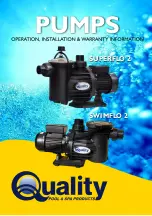
12
It is extremely important to keep seal faces clean during
assembly. Dirt particles lodged between these faces will
cause the seal to leak. Place spring (28c) over shaft and in
place on rotating member (28b), making sure it is seated
on retainer and not cocked or resting on bellows tail. Slide
retaining ring (28d) over shaft and let rest on spring (28c).
Replace snap ring (32) in groove of shaft. Set square-ring
(27) in groove on outer seal plate (29) and place outer seal
plate (29) onto inner seal plate (5). Replace socket head cap
screws (64) and torque to 60 in-lbs.
Outer Seal (All Units) -
Press stationary member (28a) firmly
into outer seal plate (5, or 29 on DS Units) as described
above. Slide rotating member (28b) onto stationary member
using seal pusher as described above. Place spring (28c) and
retaining ring (28d) onto rotating member (28b). Assemble
impeller and volute as outlined in paragraph F-2.2. Replace
oil as outlined in paragraph F-1.4.
F-4) Motor and Bearing Service
F-4.1) Disassembly and Inspection:
To examine or replace the motor (7), capacitor (9, single
phase units), controls (56, optional), and bearing (25), drain
oil from motor as outlined in paragraph F-1.1. Disassemble
volute and impeller as outlined in paragraph F-2.1 and
disassemble shaft seal as outlined in paragraph F-3.1.
Position unit upright, using blocks to avoid resting unit on
shaft. Unscrew cable hex bolts (11) and remove compression
flange (16a) and power cord (16). Remove snap ring (19) with
a flat head screwdriver. Pull the terminal block (21) out of the
housing (6) using a T-bolt or a pair of pliers and a .25-20 screw
in the threads of the terminal block (21). Be sure to leave
slack on the motor leads connected underneath. Use needle
nose pliers to pull each female connector off of the pins on the
underside of the terminal block (21), see Figure 10.
The unit voltage should be noted. Repeat cable and terminal
block removal procedure for any control cables (56) if
equipped. Remove socket head cap screws (47). Vertically
lift the motor housing (6) from seal plate (5) by lifting handle
(13). Inspect square ring (27) for damage or cuts. Remove
the motor bolts and lift motor stator from seal plate (5).
Disconnect capacitor leads from capacitor (9, single phase
units). Examine bearing (25) and replace if required.
If replacement is required, remove bearing (25) from motor
shaft using a wheel puller or arbor press, see Figure 11.
Check motor capacitor (9, single phase units) with an Ohm
meter by first grounding the capacitor by placing a screwdriver
across both terminals and then removing screwdriver. Connect
Ohm meter (set on high scale) to terminals.
If needle moves to infinity (∞) then drifts back, the capacitor
is good. If needle does not move or moves to infinity (∞) and
does not drift back, replace capacitor (9). If moisture sensors
(4, optional) are damaged, disconnect leads by removing
machine screws (45) and washers (46) from probes (4).
Remove probes (4) from seal plate (5). To test the temperature
sensor (50, optional), check for continuity between the black
and white wires. If found to be defective, contact a motor
service station or Barnes Pumps Service department. Inspect
motor winding for shorts and check resistance values. Check
rotor for wear. If rotor or the stator windings are defective, the
complete motor must be replaced.
IMPORTANT! - All parts must be clean before
reassembly.
F-4.2) Reassembly:
Moisture Sensors-
If pump is equipped with optional
moisture sensors, reassemble by applying thread compound
to threads on probes (4) and install in upper seal plate (5),
see Figures 19 & 20. Connect wire assemblies (53) to probes
(4) with washers (46) and machine screws (45).
Thermal Sensors-
If pump is equipped with optional thermal
sensors use terminal connectors (52) to connect wire
assemblies (51) to sensor leads. If found to be defective,
contact a motor service station or Barnes Pumps Service
department.
Bearings-
When replacing bearing, be careful not to damage
the rotor or shaft threads. Clean the shaft thoroughly. Press
bearing (25) on the motor shaft, position squarely onto the
shaft applying force to the inner race of the bearing only, until
bearing seats against the retaining ring (24) (Included with
motor).
FIGURE 11
FIGURE 12
Summary of Contents for Barnes DS Series
Page 15: ...15 FIGURE 15 CONTIUED ...
Page 17: ...17 FIGURE 16 EH L Series Single Seal ...
Page 18: ...18 FIGURE 17 EH L Series Single Seal Used with Cast Iron Impeller 33 ...
Page 19: ...19 FIGURE 18 EH DS Series Double Seal ...
Page 20: ...20 FIGURE 19 EH DS Series Double Seal 66 USED WITH CAST IRON IMPELLER 33 ...
Page 23: ...23 Notes ...
Page 24: ...24 Notes ...











































